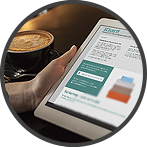Differentiate between “store” and “do”
Datum: 2025-09-16 09:09

“Storing” and “doing” are not the same thing. Things that need to be done have a definite ending — when you have done them. Once you have done whatever it is, you can tick it off, remove it from the list, cross it out. That which needs to be stored will remain — and should do so, for a long time to come, perhaps indefinitely. It should not be removed until it is obsolete and no longer needs to be available.
For you who prefer listening to reading, this post is also available as an episode of the ""Done!"" podcast:
Easy to confuse
The person who mixes up “to store” and “to do” makes life hard for him- or herself. I sometimes see this happening in tools used to keep track of all the things we need to do — either on collaborative surfaces or on our very own to-do lists.
It can be tools such as a digital to-do list in Todoist or ToDo or it can be in a collaborative tool such as Planner or Trello.
It just happens
A couple of people decide to do something together and choose a collaborative tool to keep track of all the things they need to do. They create cards or tasks from all the activities, group them according to themes, and assign tasks to everyone involved in the project. They thereby ensure they have a great overview of what is left to do — such a good overview, in fact, that the tool slowly becomes a place where they “keep track of everything”.
Pretty soon someone reasons that it would also be great to be able to quickly and easily find the document you need when working on a certain currently important theme or task. The person adds a new card to which they attach the document with the intention of making it easily accessible. And thus begins the deterioration, the downhill leading to a complete mess, away from the great overview and excellent structure.
The number of cards with materials attached to them (which in all honesty are “storage”-cards rather than “to do”-cards) increase (“since it is so practical to keep it all in one place”) and it keeps getting harder and harder to see which cards contain to-do tasks and which are just holders of relevant information. The overview no longer contains what is still left to do, but a little bit of everything. What a mess.
Do this
If you want to avoid the particular mess created when mixing “to store” with “to do”, take a hard look at the place or tool which you turn to for a complete overview of everything you (either yourself or you as a group) have left to do, and see if you can find something that is not a to-do task but was placed there for easy reference — meant to stay indefinitely.
If you find information or documents that are passive, meaning things that are something else than to-do tasks, in the overview, move them to the place where you store information and documents you want easily available when needed, but off the to-do list. You can remove the card completely if it only contains links to documents placed elsewhere.
Well done! You have now cleaned up your “to do”-overview and are back on track in terms of your structure. The overview will become much easier to decipher from now on, I promise.
Less admin, more done
If you keep things from the categories “to store and save” and “to do” in separate locations, you will actually find your materials faster and keep track of what you need to get done easier. Less looking for things, fewer wrong clicks, and less time wasted. You will get more done in the end, and spend less time simply moving things around or administrating notes. Sounds great, don’t you think?
What’s your way?
If you are being honest, is your overview also a jumbled mess of both reference materials and tasks? If this used to be the case but is no longer so, how did you solve the problem? Please write and share how you managed to sort this particular mess out.
(Speaking of different tools and keeping them organized. Feel free to also read my post “Decide what tool you will use for what purpose”)
Do you want even more ideas?

If you want more tips on how to create good structure at work, there are many ways to get that from me - in podcasts, videos, books, talks and other formats.




